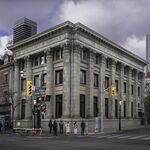On March 10, 2016, City Council added a large collection of turn-of-the-century commercial properties along Queen Street East between the DVP and Broadview Ave to the City of Toronto Heritage Register, citing their collective value as inherent to the historic architectural and cultural history of the surrounding Riverside District.
To be added to the registry are the remnants of the 1889-90 Smith Block, which includes six properties from 639 to 655 Queen St East, a collection of assorted historic properties located on the north side of the street from 650 to 688 Queen St East, and the 1903-4 Dr. John B. Fraser House at 685 Queen St East.
 The Smith Block, Queen St East, 1910, City of Toronto Archives
The Smith Block, Queen St East, 1910, City of Toronto Archives
Built up during the 1880s/90s, this stretch of Queen St East contains a significant amount of historic two-and-three-storey commercial properties which exhibit an easily identifiable adherence to the Richardsonian Romanesque architectural style which was at the height of its popularity at this time. Named after American architect Henry Hobson Richardson, the style is defined by its distinctive use of decorative red-brick and/or stone facades, complete with arched window and door openings, the inclusion of turrets and towers, small clusters of decorative columns, and a reliance on heavy-cut stone accents and foundations. Two of the most prominent examples of this style in action are found at Old City Hall, and the Ontario Legislative Building at Queen's Park.
The Smith Block (1889-90)
Beginning with the Smith Block, which includes 639, 641, 643, 651, 653, and 655 Queen St East, Heritage Preservation Services have included a long list of architectural and historical attributes to this once contiguous set of properties dating to 1889-90. Originally built as a block of nine properties - a grand central hall flanked on each side by four units - the remaining six properties of the former Smith Block all retain a significant amount of their Richardsonian Romanesque design elements, including their decorative brickwork and arches, upper-level arched windows, along with many of the building's original stone details. Historical records show that in 1961, just a year after an application was filed to obtain permission to store chemical solvents in the central portion of the block, a devastating fire destroyed the central hall, which was subsequently replaced with a surface lot and loading bay.
![The Smith Block, 2015, image courtesy of Heritage Preservation Services [HPS] The Smith Block, Queen St East](https://cdn.skyrisecities.com/sites/default/files/images/articles/2016/03/20239/20239-68971.jpg) The Smith Block, 2015, image courtesy of Heritage Preservation Services [HPS]
The Smith Block, 2015, image courtesy of Heritage Preservation Services [HPS]
Designed by the Toronto-based architectural firm of John W. Mallory and Frank S. Mallory Sr.—whose work can be found can be found throughout Riverdale and elsewhere—the Smith Block was built for John Smith whose family lineage can be connected back to John Scadding and William Smith who arrived along with of Lieutenant Governor John Graves Simcoe to York in 1793. Significant thus for both the site's architectural and cultural contexts, the inclusion of the Smith Block to the Heritage Register passed through City Hall without issue.
650-88 Queen Street East
To the north side of the street, an assortment of historic properties dating from the 1880s to 1910s, located at 650, 666, 668, 670, 682-88 Queen St East, have also been added onto the City of Toronto Heritage Register. Highlights include the 1906-7 Edwin Hotel at 650 Queen St East, the 1886-7 Richard K. O'Keefe houses at 668-70 Queen St East, and the 1892-3 Joseph White Building at 682-6 Queen St East.
 Workers laying tracks along Queen, looking east from the Don Bridge, 1923, City of Toronto Archives
Workers laying tracks along Queen, looking east from the Don Bridge, 1923, City of Toronto Archives
Built in 1906-7, the three-storey Edwin Hotel was built in the Beaux Arts style popular at the time, and includes a 1949-50 Moderne style stair addition which extends the building to the east. Cited for the structure's architectural significance in both its original and mid-century segments, the former is noted for its yellow-brick cladding and moulded brick detailing and rectangular panels, the latter for its period-specific cast stone elements and fluted panels. Today the former hotel is owned by Riverdale Co-operative Houses, and exists as affordable housing.
 The Edwin Hotel, 2008, HPS
The Edwin Hotel, 2008, HPS
Over to 668-70 Queen St East, 1886-7 Richard K. O'Keefe houses have been included for their unique scale and massing, the gable roof with two dormers featuring a distinctive fish scale shingles, and the red brick cladding with buff brick details. The structure is also representative of being among the last such house-type buildings to be built along this stretch of Queen St East before the proliferation of more typical, commercial structures began to appear along the busy thoroughfare.
 Exterior and detail shot of Richard K. O'Keefe houses, 2015, HPS
Exterior and detail shot of Richard K. O'Keefe houses, 2015, HPS
A few doors down to 682-6 Queen St East, the impressive 1892-3 Joseph White Building, complete with its ornate over-sized windows, and delicate brickwork, has also been included on the Heritage Register. Another fine example of the Richardsonian Romanesque style, the building features highly decorative bay windows framed with richly-carved wood elements and multiple-paned sash over single panes done which bring a touch of Queen Anne Revival to the overall look and feel of the building. The last of a series of Richardsonian Romanesque examples which includes the aforementioned Smith Block, and the nearby Broadview Hotel (formerly the 1891-2 Dingman's Hall), the Joseph White Building stands out as the fanciest of the lot, its inclusion on the Heritage Register a definite victory for the historical integrity of the neighbourhood.
 Joseph White Building, 2012, HPS
Joseph White Building, 2012, HPS
Dr. John B. Fraser House (1903-4)
Back across to the south side of the street, the 1903-4 Dr. John B. Fraser House located at 685 Queen St East has also made it onto the Heritage Register, the large red-brick home cited for both its architectural merits, along with its significant historical context. Built at the turn of the century for a prominent Toronto doctor, the home was sold and converted in 1919 into a funeral home by the Washington Fleury Burial Company, later sold once more after the Second World War and converted into seven apartments, until being bought by Riverdale Co-operative Houses in the 1970s, to which purpose it has been serving to this day.
 Dr. John B. Fraser House, 2015, HPS
Dr. John B. Fraser House, 2015, HPS
The Dr. John B. Fraser house was designed by Toronto architect Charles F. Wagner, whose portfolio includes the Plaza Theatre (today known as the Opera House). The house features a mix of Richardsonian Romanesque details, such as the detailed red-brick decorative elements, window arches, and columns, while also including some more modern twentieth-century touches, such as the Tudor-Revival half-timbering present on the gables, and the overall blockiness of home's massing and street presence.
Pending Further Study
While all of the recent additions to the City of Toronto's Heritage Register have proceeded, there remains one additional structure, at 635 Queen St East, which pending further study may or may not be added to the list. The structure in question is a mid-century warehouse dating to 1949, which housed Coca-Cola Ltd., the Coleman Lamp & Stove Manufacturing Co. Ltd., and McCall Corporation Distributors as of 1950. Initial findings demonstrate a lack of either architectural or historical merit, the building adding little if any value to the Riverdale District. All of this aside the building would likely make an excellent location for a hard loft or converted office space, its solid bones and interesting industrial heritage a definite plus.
 635 Queen St East, 2016, HPS
635 Queen St East, 2016, HPS
Parting Thoughts
Taken as a whole, the recent slate of inclusions to the City of Toronto's Heritage Register are definite boon to the historic Riverdale District, and will hopefully go a long way towards to the preservation of this distinct stretch of Queen St East. With the pending re-opening of the Broadview Hotel—which promises to be something akin to a Gladstone/Drake East—and the redevelopment of adjacent lands immediately to the south into Riverside Square, the area centred around Queen and Broadview will soon become one of the city's most desirable neighbourhoods. Along with this ongoing transformation, it will be exciting to see how the city handles what will inevitably become a series of gentrification and further redevlopment proposals for this area in years to come. The balance of heritage and new development, as always, will prove to be especially challenging in an area as rich with as this with historic, architectural landmarks.

 3.1K
3.1K 








































